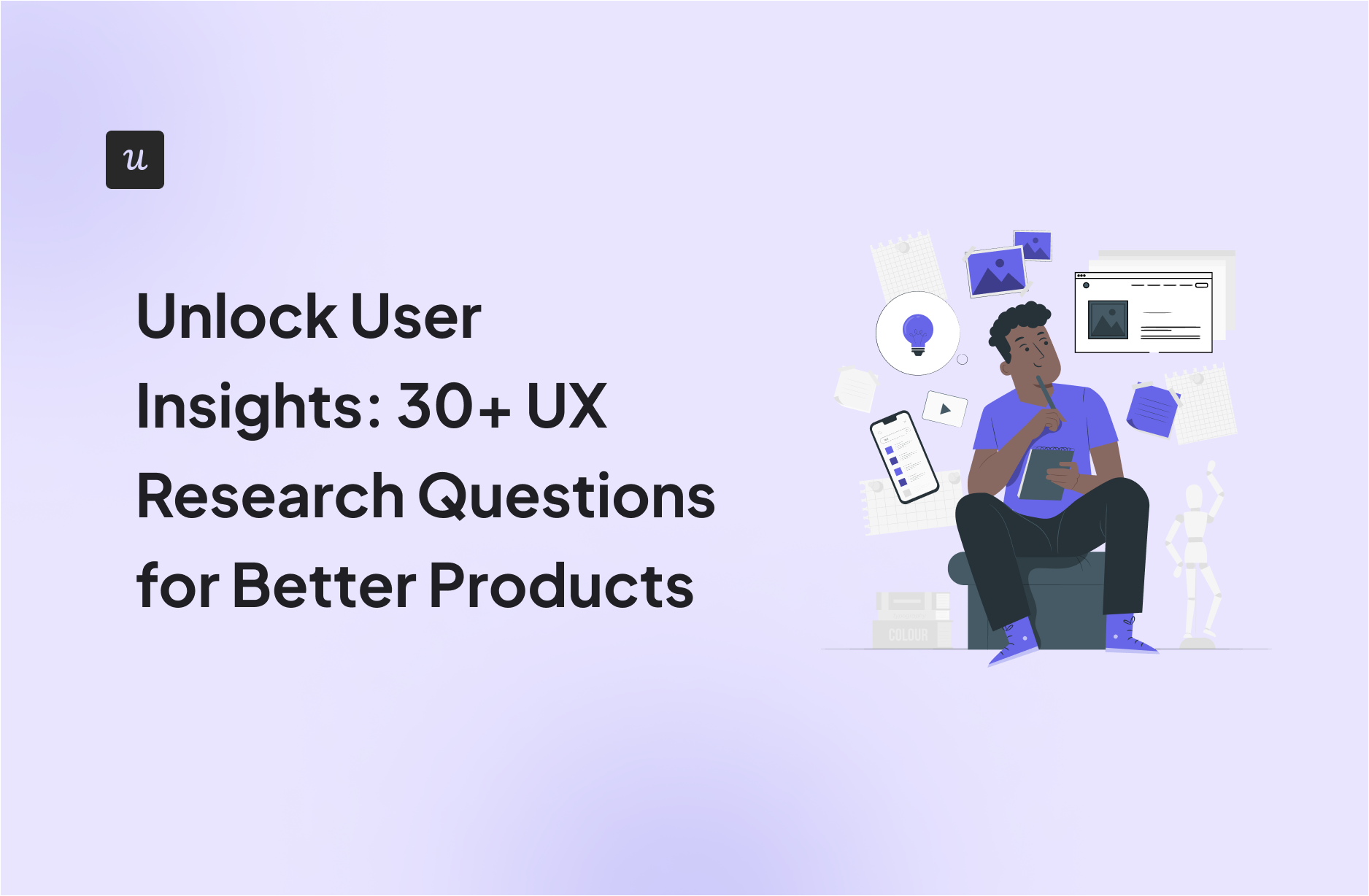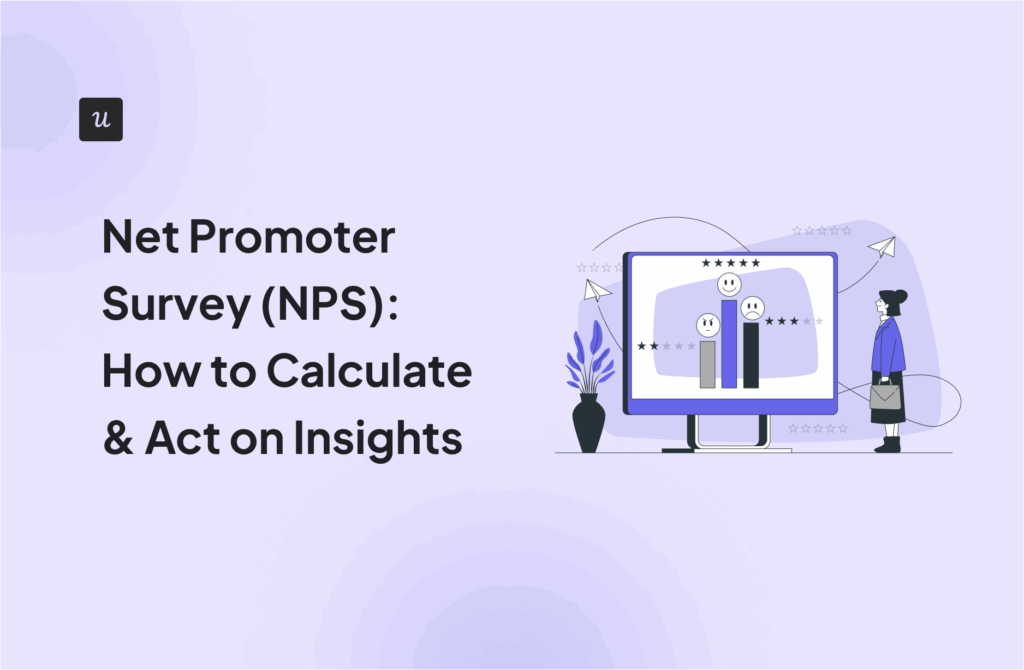
Unlock User Insights: 30+ UX Research Questions for Better Products
User research questions are crucial for gathering insights into user behavior, needs, and pain points. Whether you’re in product, design, marketing, or engineering, asking the right questions helps you build better products. These questions, whether quantitative or qualitative, help uncover user insights regarding their perception, needs, behavior, and experience with your product.
But crafting effective user research questions isn’t always easy. This article will guide you through the process, showing you:
- How to craft questions that elicit valuable feedback and how to collect valuable feedback.
- Examples of UX research questions you can adapt for your own research.
- Best practices to ensure your user research yields actionable results.
Product Growth in the Age of AI
Free LIVE online conference
What are the common types of user research questions?
User research is broad, but when surveying SaaS users, questions generally fall into three categories. These categories help you frame your UX research and gather targeted insights.
- User research questions to understand the problems: These questions uncover the pain points and challenges your ideal customers face. By analyzing responses, you can iterate on your product to better meet user needs. Use these questions to:
- Brainstorm new product ideas.
- Design a product sprint.
- Design feature enhancements.
- Improve product usability.
- User research questions to understand user preferences: These questions help you understand your target audience. By understanding what makes your audience tick, you can identify factors that influence their buying decisions and the tasks they accomplish daily. Use these questions early in product development to:
- Design data-driven user experiences.
- Identify features that will drive product adoption.
- Understand the preferred pricing structure and your users’ WTP (willingness to pay).
- User research questions about the product experience: The overall product experience shapes how users perceive your brand and determines whether they continue doing business with you. Surveys about the user experience can help you:
- Improve the product experience and usability.
- Guide new features and enhancements.
- Discover churn reasons.
Examples of user research questions to understand the problem
To gain insights into user problems and identify solutions, use the following questions. These UX research examples will help you uncover pain points and areas for improvement.
Qualitative research question examples
- What problems are you looking to solve with this product?
- What is the main goal when completing [a task in the product]?
- Can you describe a time when you were struggling to use [product/feature] and how you eventually overcame the challenge?
- Are there any recurring issues or problems that, if resolved, would significantly enhance your overall satisfaction with our product?
- What features or functionality are missing from our product that would make it more useful for you?
Practical Framing: Use these questions in user interviews or open-ended survey questions to gather detailed, narrative feedback.
Quantitative research question examples
- How hard is it to accomplish [task]?
- On a scale of 1 to 7, how challenging do you find [specific features of your product] to use?
- How likely are you to recommend our product to others based on your current experience?
- What is the likelihood that you will switch to a competitor product in the next six months?
- How often do you have to contact our customer support team for assistance?
- Indicate your level of agreement with the statement: “The current version of [product] adequately addresses my primary pain points.”
Practical Framing: Use these questions in in-app surveys to quickly gauge user sentiment and identify trends.
Examples of problem research questions to understand user needs
To understand user needs, preferences, and willingness to pay, use the following qualitative and quantitative survey questions at the right points in the user journey. These ui ux research questions will help you tailor your product to meet user expectations.
Qualitative research questions
- Describe the problem you are trying to solve as a [user persona].
- What tasks do you accomplish in an average workday?
- Can you describe one particular feature you find most valuable in a product like ours?
- Are there any missing features you’ll be willing to pay extra for?
- How do you currently address gaps or limitations in our product? Are there workarounds you’ve developed?
- How important is mobile accessibility in your workflow, and what features would you consider essential for a mobile version of our product?
- When it comes to integrations with other tools or platforms, which integrations would be most beneficial for your workflow?
- What has been the biggest hurdle in using [feature]?
Practical Framing: Use these questions in user interviews to gain a deeper understanding of user motivations and workflows.
Quantitative research questions
- On a scale from 1 to 5, how difficult is it to accomplish [a task]?
- What are the top three tasks you complete most often with our product? (List the most common tasks in your tool to make it easy for users to simply click an option)
- To what degree do you value product updates and new feature announcements in maintaining your interest in a SaaS product?
- How likely are you to consider upgrading to a higher pricing tier for access to premium features?
- How much would you be willing to pay for a solution to [problem]?
Practical Framing: Use these questions in surveys to gather quantifiable data on user preferences and willingness to pay.
Examples of product research questions to improve user experience
To learn more about the user experience and identify ways to improve usability and retention, use the following questions. These ux research questions will help you optimize your product for user satisfaction.
Qualitative UX research questions
- What were your initial expectations when you started using our product, and how did the actual experience compare?
- How would you describe the organization and clarity of our menu and interface labels? Are there any terms or options that are unclear to you?
- How can we improve your experience with the product?
- Are there any features you rarely use, and if so, can you explain why?
- Can you describe a time when you were struggling to use our product and how you eventually overcame the challenge?
- Have you used similar products or competitors in our industry, and if so, what aspects of their user experience do you find better or worse than ours?
- If you were to stop using the product, what would be the main reason?
Practical Framing: Use these questions in usability tests or user interviews to gather in-depth feedback on the user experience.
Quantitative UX research questions
- On a scale of 1-10, how was your experience with [task]?
- On a scale from 1 to 5, rate how easy it is to use [product].
- How often do you encounter problems completing the following tasks with our product? (List the tasks)
- On a scale from 1 to 10, how likely are you to recommend this product to a friend?
- How easy is it to find the information you need to complete tasks with our product?
- Indicate your agreement with the statement: “My overall satisfaction with [product] has increased over time.” (strongly disagree, disagree, neutral, agree, strongly agree)
- How would you rate your overall experience with [product]?
Practical Framing: Use these questions in post-task surveys to quickly assess user satisfaction and identify areas for improvement.
More examples of user research questions
To further enhance your user research, consider these additional questions tailored to different aspects of the user journey and product development:
Feature prioritization questions
- Which of the following features would be most helpful to you? (Provide a list of options)
- How would you rank the importance of these features on a scale of 1 to 5?
- What problems would this feature solve for you?
Practical Framing: Use these questions when deciding which features to prioritize in your product roadmap.
Usability testing questions
- While using this feature, what was your thought process?
- Did you find anything confusing or unexpected?
- How would you improve this process?
Practical Framing: Ask these questions during usability testing sessions to understand how users interact with specific features.
User onboarding questions
- How easy was it to get started with our product?
- What was the most confusing part of the onboarding process?
- What resources would have been helpful during onboarding?
Practical Framing: Use these questions to optimize your user onboarding process and improve user activation. With Userpilot, you can create personalized onboarding experiences based on user segments and behaviors.
Customer satisfaction questions
- How satisfied are you with our product overall?
- What do you like most about our product?
- What could we do to improve your satisfaction?
Practical Framing: Regularly ask these questions to gauge customer satisfaction and identify areas for improvement.
Best practices when conducting user research
To collect honest answers, choose and phrase your survey questions carefully. Here are three best practices when rolling out user research questions:
Ask concise questions and be specific
Concise questions help participants clearly understand the information you’re seeking, preventing confusion and ensuring relevant insights.
Avoid product or industry jargon, as not all participants might be familiar with them.
Focus on asking specific questions—ideally, one idea per question. This makes it easier for users to respond and helps you analyze better and faster.
Here’s an example of an incorrect survey question: “How satisfied are you with the ease of navigation and the responsiveness of customer support in our product?”
This question combines two distinct ideas—satisfaction with ease of navigation and satisfaction with customer support responsiveness—into a single question. Respondents may have differing opinions on each aspect, making it challenging to pinpoint specific areas for improvement. It also doesn’t allow participants to express nuanced feedback on each element separately.
Avoid asking leading questions
Leading questions are intentionally or mistakenly worded in a way that suggests or pushes respondents toward a certain answer.
Example: “Was the product very easy to navigate?”
This question is leading because it suggests a positive outcome and assumes agreement with the statement. Respondents may feel compelled to respond positively even if they don’t genuinely believe the product has easy navigation, introducing bias and resulting in inaccurate data.
A better phrasing would be, “How would you describe your experience with navigating the product?”
Let’s consider another example.
What do you think about the survey question below?
“Is feature A better than feature B? (Yes/NO)”
Leading or not?
Binary questions can be tricky because the phrasings inherently imply comparison; however, the above question is leading.
A better way to frame it for unbiased responses is to ask: “Do you prefer feature A or B?”
Use a mix of closed-ended and open-ended questions
This is known as mixed-method research, and experts use it to get both qualitative and quantitative feedback for better insights.
Closed-ended questions provide quantitative data that you can quickly analyze to generate actionable insights. On the other hand, open-ended questions offer qualitative feedback, uncovering the “why” behind quantitative responses.
When designing your survey, strike a balance between closed-ended and open-ended questions. Ensure closed-ended questions cover key metrics, while open-ended questions delve into user perceptions and experiences.
Sometimes, it’s effective to start with quantitative questions to gather baseline data and then ask open-ended follow-up questions to explore nuances and gather rich qualitative data.
For example, you can trigger an NPS survey that asks users on a scale of 1-10, how likely they are to recommend your new feature, then send a follow-up asking the reasons for their scores.
How to collect responses to user research questions
There are multiple user research channels. The ones you choose boil down to your audience and research goals. For SaaS participants, in-app surveys, user interviews, and usability tests work great.
Use in-app user feedback surveys to gauge satisfaction
Meet customers where they are with contextual in-app surveys that let you collect input on the spot. This real-time feedback is valuable for understanding immediate user experiences and satisfaction levels.
For instance, triggering a CSAT survey immediately after a user interacts with your new feature lets you get more accurate feedback compared to when you wait to ask them weeks later in a one-on-one interview.
By integrating surveys into your app, you engage users without requiring them to switch to a different platform. This convenience encourages higher participation rates.
Conduct user interviews to understand needs, preferences & experiences
When it comes to understanding user needs and preferences, interviews work better. They help you interact closely with the research participants, ask follow-up questions immediately, and generate in-depth feedback to uncover underlying motivations and reasons behind user behavior.
All these are critical to building products your users will love, especially when building an MVP to test with a new audience.
In addition, direct interactions foster empathy as you can observe non-verbal cues and emotions, gaining a holistic perspective on user experiences beyond what may be expressed verbally.
Carry out usability tests to dig deeper into product usability
Usability tests help you gauge how user-friendly your product is. The tests focus on understanding customer satisfaction with your tool and their perception of its value.
Usability tests help pinpoint specific areas of your product that may cause confusion or frustration for users. By observing users during tests, you’ll gain insights into their natural interaction patterns, allowing you to make adjustments that align with user expectations and behaviors.
Popular usability testing methods include guerrilla testing, lab testing, and remote testing. The approach you choose depends on your audience and research objectives.
Conclusion
User research isn’t a one-time task but an ongoing process of learning about users and making improvements.
Regularly conduct user research to keep track of changing customer needs and preferences. Doing this will save you from losing users to churn and ensure your product is competitive.
When you think about it critically, research boils down to asking the right questions. Your phrasing matters as much as the channels and timing. So, A/B tests different research questions to see which gives you better results.
Userpilot can help you trigger and analyze user research questions in-app. With our platform, you can:
- Design different kinds of quantitative and qualitative surveys.
- Segment users to determine who sees what.
- Set event-based triggers so your surveys are contextual. For instance, you can set your surveys to be sent after a user interacts with a new feature. This way, only users who hit that goal will see your surveys.
- A/B test different survey elements and get real-time results.
FAQ
What are common questions in user research?
Common questions in user research often focus on understanding user needs, behaviors, pain points, and preferences. Here are some examples:
User goals and motivations:
- “What are you hoping to achieve when you use [product/service]?”
- “What motivates you to use [product/service]?”
- “What problems are you trying to solve with [product/service]?”
User behaviors and experiences:
- “Can you walk me through how you typically use [product/service]?”
- “What are the steps you take to complete [specific task] using [product/service]?”
- “Are there any parts of using [product/service] that you find particularly easy or difficult?”
- “Can you describe any situations where you felt confused or frustrated while using [product/service]?”
User needs and pain points:
- “Are there any features or functionalities that you wish [product/service] had?”
- “What are some of the biggest challenges you face when using [product/service]?”
- “Is there anything that prevents you from achieving your goals with [product/service]?”
User perceptions and attitudes:
- “What are your overall thoughts and feelings about [product/service]?”
- “What do you like most about [product/service]?”
- “What do you like least about [product/service]?”
- “Would you recommend [product/service] to a friend or colleague? Why or why not?”
What are 5 good research questions?
- What are your primary goals when using this product?
- Can you describe a recent experience where you encountered difficulties using this product?
- What features do you find most valuable?
- How would you improve this product?
- Would you recommend this product to others?
How to write questions for user research?
To write any question for your use research survey, you should keep in mind the following:
- Write clear, open-ended questions that encourage detailed responses.
- Avoid jargon and leading questions.
- Focus on understanding the user’s perspective.
What are examples of leading questions in user research?
Leading questions suggest a particular answer or bias the response. Examples include: “Don’t you think this feature is great?” or “Wouldn’t you agree that this product is easy to use?”
What is the difference between user interview questions and user research questions?
User interview questions are a subset of user research questions specifically designed for one-on-one conversations. User research questions encompass a broader range of inquiries used in various research methods, such as surveys, usability testing, and field studies.
- What is UX research? UX research involves understanding user behaviors, needs, and motivations through various methods to improve product design.
- What are the types of UX research? Types of UX research include user interviews, surveys, usability testing, and A/B testing.
- What are UX research examples? Examples include conducting user interviews to understand pain points, sending out surveys to gather feedback on new features, and performing usability tests to identify usability issues.
- What is a UX research survey? A UX research survey is a method of collecting data from users through a series of questions to gather insights about their experiences and preferences.










![The Complete Guide to AI Customer Feedback [+ 7 How-To Steps for SaaS] cover](https://blog-static.userpilot.com/blog/wp-content/uploads/2025/09/the-complete-guide-to-ai-customer-feedback-7-how-to-steps-for-saas_844e48b93d67a6366faa8dfe6e153030_2000-1024x670.png)



